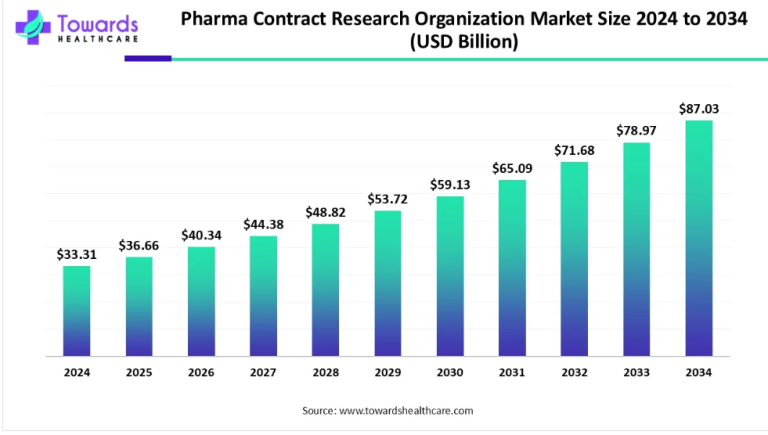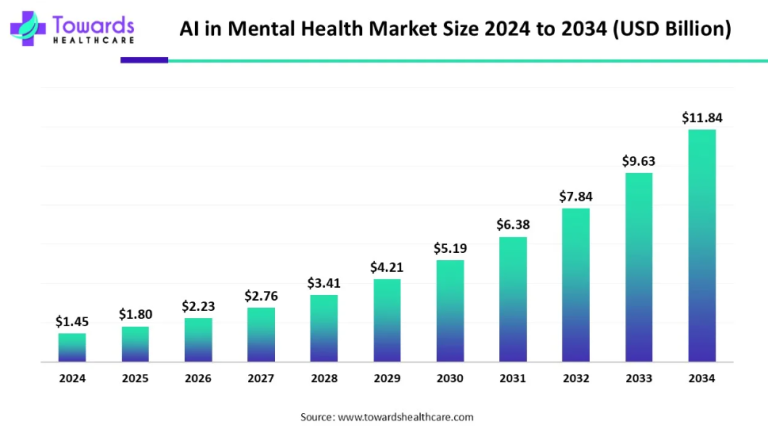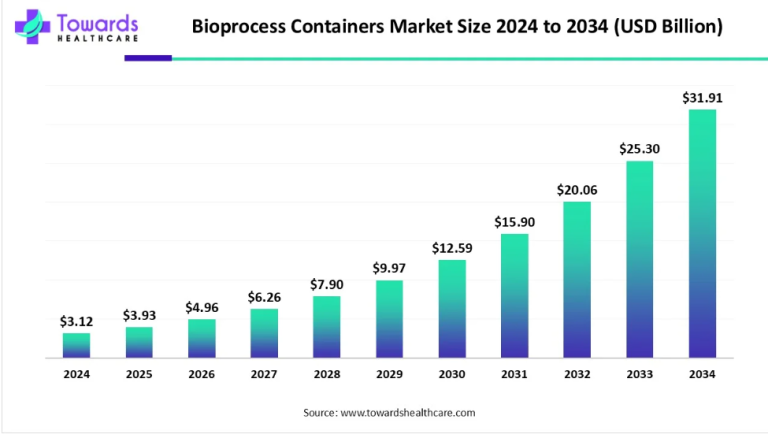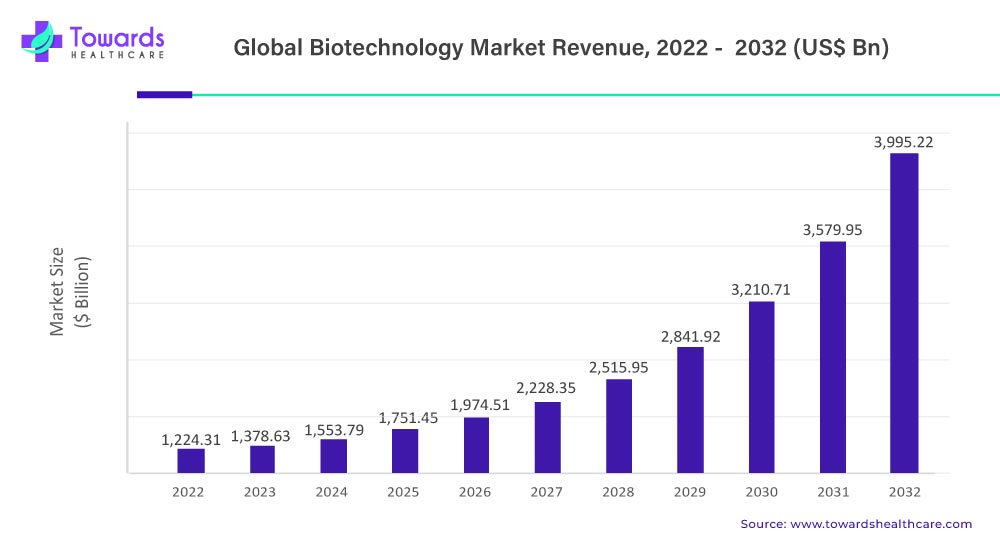
In the ever-evolving landscape of the biotechnology market, a surge in growth is on the horizon. The global biotechnology market, valued at USD 1,224.31 billion in 2022, is projected to experience a substantial upswing. Anticipated to grow at an impressive 12.5% Compound Annual Growth Rate (CAGR) from 2023 to 2032, the market is poised to reach a staggering USD 3,995.22 billion by the end of the forecast period.

Driving Forces: Innovation and Technological Advancements in Biotechnology Market
The Engine of Growth: Innovation in Biotechnology
At the core of this remarkable expansion lies a continuous wave of innovation within the biotechnology market. Pioneering research and development initiatives are steering the sector towards unprecedented breakthroughs. Novel approaches to healthcare, agriculture, and industrial processes are propelling the market forward, laying the foundation for its substantial growth.
Technological Advancements: Catalysts for Transformation
The relentless pursuit of technological excellence is another key driver fueling the surge in the biotechnology market. Advancements in gene editing, synthetic biology, and precision medicine are reshaping the industry’s landscape. This technological prowess not only enhances the efficiency of biotechnological processes but also opens new frontiers for exploration and application.
According to Steve Jobs, the most significant advancements of the 21st century would arise from the convergence of biology and technology
The global biotechnology market refers to the industry that uses living organisms or biological systems to develop new products, services, and technologies for healthcare, agriculture, industrial applications, and other fields. This market encompasses a wide range of sectors, including biopharmaceuticals, biotechnology market research and development, bioprocessing, genomics, proteomics, bioinformatics, and synthetic biology.
The global biotechnology market has been growing rapidly in recent years, driven by a number of factors such as increasing demand for innovative treatments for chronic diseases, rising investments in research and development, advances in technology, and increasing government support. Biotechnology market research and development often involves genetic engineering, gene editing, and other advanced techniques to modify or manipulate living organisms to produce desired traits or outcomes. Biotechnology market has revolutionized many industries and has the potential to address some of the world’s most pressing challenges, such as disease, hunger, and climate change.
The biotechnology market is witnessing significant growth due to the increasing demand for food, the rising prevalence of chronic diseases, advancements in technology, and growing government initiatives to support biotechnology research. The market is expected to witness further growth during the forecast period, driven by the biopharmaceuticals segment, DNA sequencing technology, and increasing investments in biotechnology market research and development.
Unleashing the Potential of Bio-pharmacy Applications
Biopharmaceuticals are drugs that are produced using biotechnology methods such as genetic engineering, fermentation, and cell culture. These drugs are developed using living cells, and they are designed to target specific proteins, cells, and genetic pathways. Biopharmaceuticals are used to treat a wide range of diseases, including cancer, autoimmune disorders, infectious diseases, and rare genetic disorders. The use of biopharma applications in biotechnology has had a significant impact on the development of new drugs and therapies.
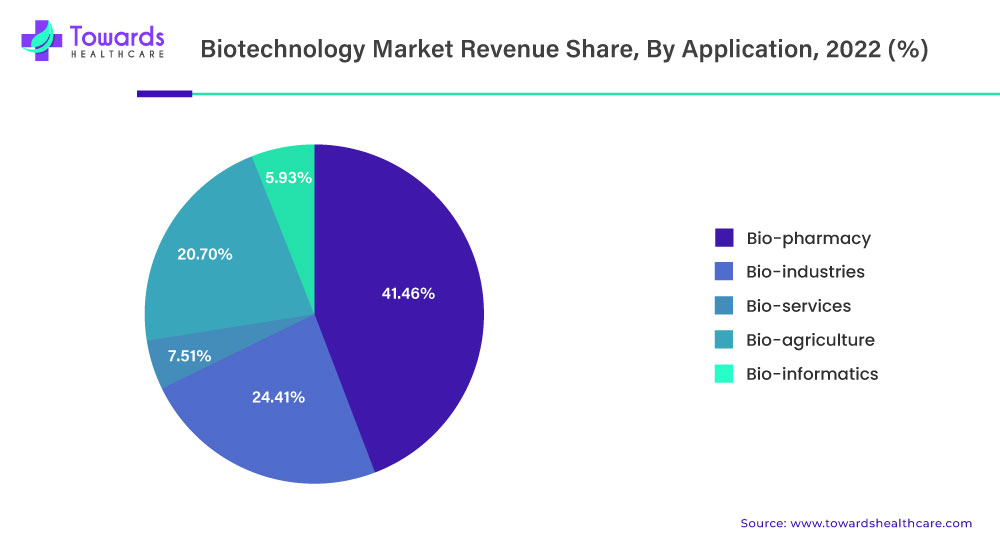
In 2022, bio-pharmacy applications held around 41.46% revenue share in the global biotechnology market and are further projected to account for the fastest growth over the upcoming years.
Biopharmaceuticals have several advantages over traditional chemical drugs. They have high specificity and potency, which means they can target specific disease-causing cells or proteins more effectively. They also have fewer side effects and are less toxic to the body than traditional chemical drugs. Biopharmaceuticals can be produced in large quantities using cell culture techniques, which makes them easier to manufacture than traditional chemical drugs. Additionally, biopharmaceuticals have a lower risk of contamination and are more stable than traditional chemical drugs.
The use of biopharma applications in biotechnology has led to the development of several successful drugs and therapies. One example is the use of monoclonal antibodies to treat cancer. Monoclonal antibodies are produced using biotechnology methods and are designed to target specific proteins on cancer cells. They have been successful in treating several types of cancer, including breast cancer, lymphoma, and leukemia.
Another example is the use of recombinant DNA technology to produce insulin for the treatment of diabetes. Recombinant DNA technology involves inserting a human gene for insulin production into a bacterial or yeast cell. The cell is then grown in large quantities, and the insulin is extracted and purified. This method of insulin production has revolutionized the treatment of diabetes and has made insulin more widely available and affordable.
Biopharmaceuticals are also being developed to treat rare genetic disorders, such as cystic fibrosis and hemophilia. These drugs are designed to replace or supplement a missing or defective protein in the body. The use of biotechnology methods to develop these drugs has led to significant advances in the treatment of rare genetic disorders.
The use of biopharma applications in biotechnology has had a significant impact on the development of new drugs and therapies. Biopharmaceuticals offer several advantages over traditional chemical drugs, including high specificity and potency, fewer side effects, and easier manufacturing. The success of biopharmaceuticals in treating a wide range of diseases has led to increased investment in biotechnology research and development.
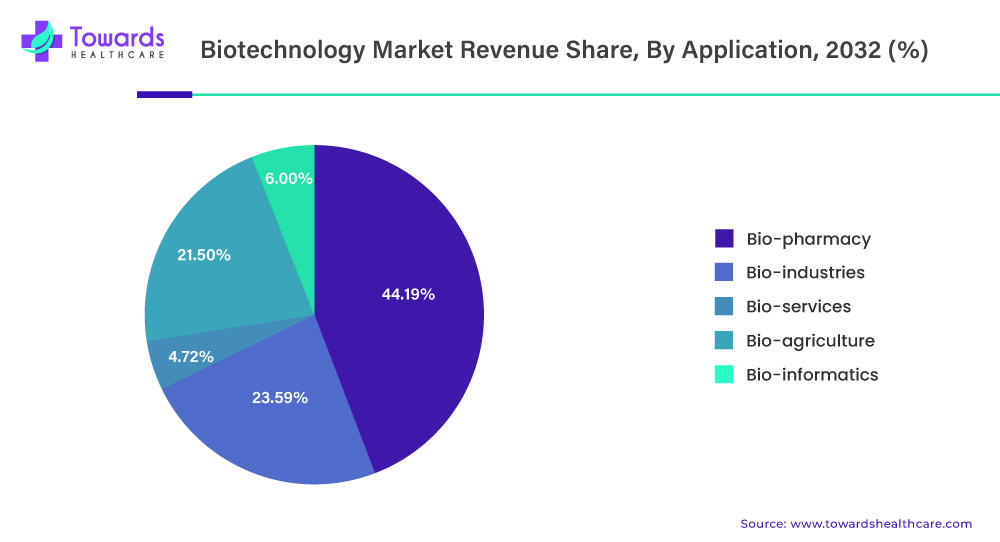
Pharmaceutical products’ use in personalized medical therapy is probably going to open up profitable business opportunities for market participants. In the upcoming years, it is anticipated that the prevalence of chronic diseases will rise, the biopharmaceutical industry will expand quickly, and healthcare spending will rise. A rich pipeline of innovative therapeutic substances and increased technology breakthroughs in the treatment of chronic diseases are also expected to boost the global market.
In addition, Research on stem cells, one of the revolutionary bio-pharmaceutical uses, is proceeding at an accelerated rate. Its main goal is to create highly customized treatments from the patient’s own cells. Similarly, genetic engineering entails changing a patient’s genetic makeup to identify specific regions of interest. The development of personalized medical care is being investigated, with biotechnology being incorporated. Businesses in the biotechnology industry now possess a competitive advantage attributable to the implications of cloud computing, artificial intelligence, and increased concentration on R&D. Furthermore, gene therapy, pharmacogenomics, genetic testing, and the development of biopharmaceuticals are the different applications of bio-pharmacy.
North America Dominated the Market while Asia Pacific is Projected to Register Fostering Growth in the Upcoming Years
North America was the largest contributor to the global biotechnology market, with a 37.76% market share in 2022. However, the Asia Pacific will exhibit the fastest growth over the upcoming years. North America is a significant market for biotechnology, with the United States being the largest contributor to the region’s growth. The North American biotechnology market is driven by the presence of a large number of pharmaceutical and biotech companies, as well as government support for research and development activities.
Additionally, the region’s move toward manual mechanization in the biotechnology, pharmaceutical, and related industries is driving demand for faster, easier-to-use equipment. Furthermore, Amgen Inc., CSL Ltd., Novo Nordisk A/S, Bristol-Myers Squibb Co., Merck & Co., Johnson & Johnson Services Inc., AstraZeneca PLC, and Pfizer Inc. are among the businesses that are helping North American biotechnology market growth.
The United States dominates the North American biotechnology market due to the presence of major players, a well-established regulatory framework, and a large patient pool. In 2022, the United States held a market share of around 47% in the North American biotechnology market. The growth of the biotechnology industry in the US is supported by increasing investment in research and development, favorable government policies, and the presence of leading academic and research institutions.
Biotechnology Market Revenue Share, by Region 2022 (%)
| Region | Revenue Share in 2022 (%) |
| North America | 37.76% |
| Asia Pacific | 23.80% |
| Europe | 28.77% |
| LAMEA | 9.66% |
On the other hand, the Asia Pacific region is one of the fastest-growing markets in the global biotechnology industry with around a projected 22% of the market share in 2032. The region is witnessing an increasing demand for biotechnology products and services, owing to the growing prevalence of chronic diseases, increasing investments in R&D, and government initiatives to promote the biotechnology sector.
Countries such as China, Japan, India, South Korea, and Australia are the major players in the Asia-Pacific biotechnology market. China and India are expected to drive the growth of the market due to the presence of a large population base, increasing healthcare expenditure, and rising prevalence of chronic diseases. For instance, the Indian government allocated US$ 162.7 million to the Department of Biotechnology (DBT) in the Union Budget 2023-24 to support the advancement of research and development.
In recent years, the Asia Pacific biotechnology industry has witnessed significant developments, such as the establishment of biotechnology parks, partnerships, and collaborations between companies, and an increasing number of clinical trials. For instance, in September 2022, the Chinese biotech company CanSino Biologics Inc. received approval from the Chinese government for their COVID-19 vaccine as an emergency use booster.
Technological Innovations are Uplifting the Market Growth
With the rapid development of new technologies, such as CRISPR/Cas9 gene editing, synthetic biology, and gene therapy, the biotechnology market is rapidly evolving and expanding. These technologies have enabled the development of new and innovative products, such as biopharmaceuticals and genetically modified organisms, that have the potential to revolutionize the healthcare and agriculture industries.
Advances in biotechnology have led to the development of new and innovative products, such as biopharmaceuticals and genetically modified organisms. These products have revolutionized the healthcare and agricultural sectors, providing more efficient and effective solutions to longstanding problems.
In addition, technological advancements have improved the speed and accuracy of research and development in biotechnology market. Tools such as genome sequencing and gene editing have allowed for more precise and targeted research, leading to the discovery of new treatments and therapies. For instance, one of the significant advancements is in genome sequencing and gene editing, which has allowed for more precise and targeted research. With the ability to decode the genetic makeup of organisms, scientists can identify genes responsible for various diseases and develop targeted treatments to combat them.
Furthermore, advancements in bioinformatics and data analytics have also contributed to the growth of the biotechnology market. With large amounts of data being generated from various sources, it is crucial to have tools and software to manage and analyze the data efficiently. Bioinformatics has made it possible to store, analyze, and interpret large amounts of biological data, allowing researchers to identify patterns and relationships that were previously impossible to detect.
The ability to decode genetic makeup and use the information to develop targeted treatments has revolutionized the healthcare industry, providing personalized and more efficient treatments to patients. The use of automation and high-throughput screening has also accelerated the drug development process, enabling faster identification of potential drug candidates. As technology continues to evolve, the biotechnology market is expected to grow and innovate further, providing solutions to address some of the most pressing challenges in healthcare, agriculture, and other industries.
Moreover, technological advancements in high-throughput screening and automation have revolutionized drug discovery and development. With automated systems, researchers can process vast amounts of data and test potential drug candidates quickly and accurately, accelerating the drug development process.
The Talent Dilemma: Addressing the Shortage of Skilled Professionals in Biotech
The biotech industry has been facing a talent dilemma for several years now. As the industry continues to grow and expand, the demand for skilled professionals in various fields, such as research and development, manufacturing, quality control, and regulatory affairs, has also increased significantly. However, there is a shortage of skilled professionals to meet this demand, leading to a talent gap in the industry.
One of the reasons for the talent shortage in biotech is the lack of exposure to biotech education and training in schools and universities. Biotech is a relatively new field, and many educational institutions have not yet incorporated it into their curriculum. As a result, there is a shortage of graduates with the necessary skills and knowledge to work in the biotech industry.
Another reason for the talent shortage is the high demand for skilled professionals in other industries, such as technology and finance. These industries offer competitive salaries and benefits, making it difficult for biotech companies to attract and retain top talent. In addition, the biotech industry is highly regulated, which can deter some professionals from entering the field due to the perceived complexity and uncertainty of the regulatory environment.
In addition, the talent shortage in biotech has significant implications for the industry. It can lead to delays in the development of new treatments and therapies, as well as increased costs due to the need to outsource work to other countries or hire temporary staff. In addition, it can limit the growth potential of biotech companies, as they may not have the necessary resources to expand their operations or pursue new projects.
To address the talent dilemma in biotech, industry leaders and educators are taking steps to promote biotech education and training at all levels. This includes developing specialized courses and programs in biotech, as well as partnering with industry leaders to provide hands-on training and mentorship opportunities. In addition, biotech companies are offering competitive salaries and benefits to attract and retain top talent, as well as providing opportunities for career advancement and professional development.
Thus, the shortage of skilled professionals in biotech is a significant challenge for the industry. However, with concerted efforts from industry leaders, educators, and policymakers, it is possible to address this talent dilemma and ensure the continued growth and success of the biotech industry.
Personalized Treatment Options: Creating Exquisite Growth Opportunities
Personalized treatment options have indeed created exquisite growth opportunities for the biotechnology market. Personalized medicine involves developing therapies and treatments tailored to an individual patient’s specific genetic and molecular makeup. It allows for more precise and effective treatment, reducing the risk of adverse side effects and improving patient outcomes. With advancements in technology and research, there is a growing understanding of the genetic and molecular basis of diseases.
This has led to the development of targeted therapies and precision medicine, which aim to provide individualized treatment based on a patient’s specific genetic makeup and disease characteristics.
Additionally, there is a growing interest in regenerative medicine, which involves the use of stem cells and other advanced biologics to repair or replace damaged tissues and organs. This area of biotechnology has the potential to revolutionize the treatment of chronic diseases and injuries, such as heart disease, diabetes, and spinal cord injuries.
Furthermore, with the increasing availability of genetic and molecular data, personalized medicine is becoming more feasible and cost-effective. This has led to a significant increase in demand for personalized treatments, creating new opportunities for biotechnology companies to develop innovative products and therapies.
Moreover, personalized medicine has the potential to transform traditional healthcare practices, from prevention and diagnosis to treatment and management of diseases. It offers a shift from a one-size-fits-all approach to a more individualized and targeted approach, providing patients with better outcomes and quality of life.
The rise of personalized medicine is also driving the development of advanced technologies such as gene editing, CRISPR, and gene therapy, which are further driving growth in the biotechnology market. These technologies are enabling the development of innovative and targeted therapies, offering new treatment options for previously untreatable or difficult-to-treat diseases.
In addition to personalized medicine, the biotechnology market is also seeing a significant focus on the development of biosimilars, which are biologic products that are highly similar to already approved biologic drugs but at a lower cost. Biosimilars are increasingly being used to treat a variety of diseases, including cancer, autoimmune diseases, and diabetes, among others. The market for biosimilars is expected to grow significantly in the coming years, driven by increasing demand for cost-effective alternatives to expensive biologics.
Another trend in the biotechnology market is the growing focus on digital health solutions. Digital health technologies, such as telemedicine, wearable devices, and health apps, are being developed to improve patient outcomes and reduce healthcare costs. These technologies are also helping to drive personalized medicine, by enabling the collection and analysis of large amounts of data on individual patients.
Unpacking Growth: A Closer Examination
Diversification of Applications: Beyond Traditional Boundaries
Biotechnology is no longer confined to conventional applications. The market is witnessing a diversification of its scope, with innovations spanning healthcare, agriculture, environmental management, and more. This broadening spectrum of applications contributes significantly to the market’s growth, making it a pivotal player in addressing global challenges.
Collaborative Endeavors: Fostering Synergies
The collaborative spirit within the biotechnology community is fostering synergies that drive progress. Partnerships between research institutions, industry players, and governments are accelerating the translation of research findings into tangible solutions. This collaborative ethos not only expedites innovation but also ensures a more comprehensive approach to addressing complex challenges.
Future Outlook: A Paradigm Shift
Accelerated Growth Trajectory: A Glimpse into the Future
Looking ahead, the global biotechnology market shows no signs of slowing down. The confluence of innovation and technological prowess is expected to propel the industry into a new era of growth. With a focus on sustainable solutions and the convergence of interdisciplinary approaches, the biotechnology sector is poised for a paradigm shift.
The trajectory of the global biotechnology market is marked by a journey of innovation and transformative advancements. From reshaping traditional applications to fostering collaborative endeavors, the industry is gearing up for a future defined by unprecedented growth. As biotechnology continues to be a driving force in addressing global challenges, the forecasted surge in market size underscores its pivotal role in shaping a sustainable and technologically advanced world.
